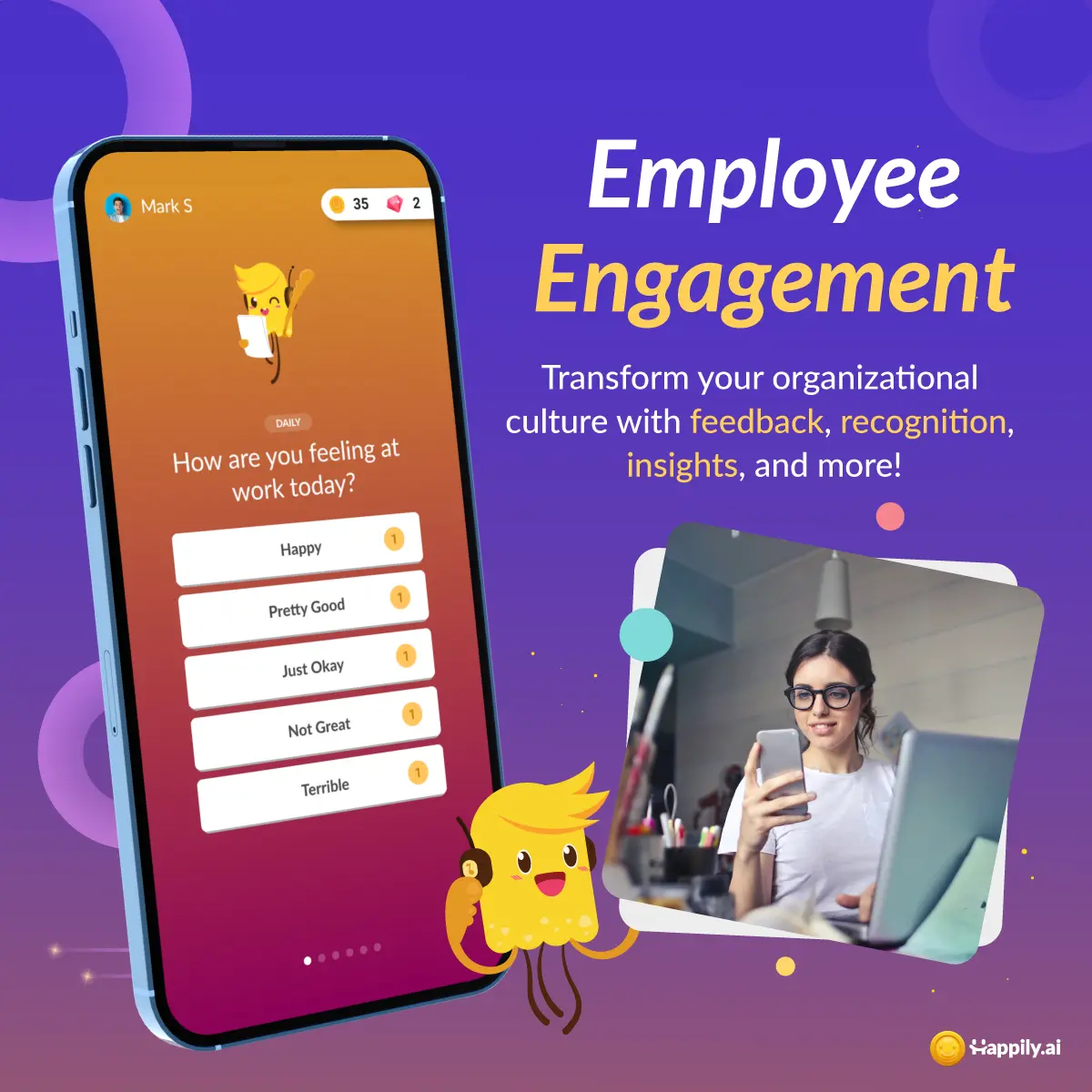Deciding whether to build or buy an employee engagement app is a critical choice for many businesses. It involves the careful weighing of cost, functionality, and time commitments. This article will analyze the cost breakdown of building an employee engagement app with features like pulse surveys, peer feedback, peer recognition, rewards, a comprehensive dashboard and analytics, personalized manager insights, and intervention design.
Building an Employee Engagement App
Developing an employee engagement app in-house can be an exciting venture, but it comes with its unique set of challenges and costs. Let's break down these costs:
- Development Costs: Development is a significant cost factor when building an app. You'll need a team of software developers, UX/UI designers, and project managers. Depending on the complexity of the app, development costs can range from $50,000 to $500,000.
- Maintenance Costs: Once the app is built, regular updates, bug fixes, and improvements are necessary to keep it running smoothly. This could amount to around 15-20% of the initial development cost annually.
- Hardware/Software Costs: You'll need servers to host the app and databases to store data. The cost of this infrastructure can vary greatly depending on the scale of your operations.
- Training Costs: Your team will need to learn how to use the app effectively. This could involve creating training materials or even hiring a training specialist.
- Time: Building an app in-house is time-consuming. It could take anywhere from 6 to 18 months to develop, depending on the complexity.
- Risk: If the app fails to deliver the expected results or runs into development problems, the cost and time invested are lost.
These cost estimates include the design and development of each feature, but not the ongoing costs associated with maintenance, updates, and potential improvements.
| Feature | Development Cost Estimate | Timeline | Risks |
|---|---|---|---|
| Pulse Surveys | $5,000 - $15,000 | 1 - 2 months | Complexity of survey design, integration with other features |
| Peer Feedback | $10,000 - $20,000 | 2 - 3 months | Ensuring anonymity, handling negative feedback |
| Peer Recognition | $5,000 - $10,000 | 1 - 2 months | User adoption, maintaining meaningful recognition |
| Rewards | $10,000 - $25,000 | 2 - 3 months | Sourcing rewards, managing redemption |
| Dashboard and Analytics | $15,000 - $30,000 | 2 - 4 months | Complex data analysis, ensuring data privacy |
| Personalized Manager Insights | $10,000 - $20,000 | 2 - 3 months | Generating useful insights, ensuring data privacy |
| Intervention Design (Questions and Nudges) | $5,000 - $15,000 | 1 - 2 months | Ensuring interventions are effective and not intrusive |
When it comes to the timeline, keep in mind that these estimates are for each feature separately. In practice, many of these features might be developed concurrently, and there would also be additional time required for integrating these features, testing, and deploying the app.
The risks column highlights some of the challenges associated with developing these features, and these should be considered during the planning and development stages to mitigate potential issues.
More Than Just a Software Product: The Science Behind Employee Engagement Apps
When considering an employee engagement app, it's crucial to understand that its development goes far beyond just software programming. At its core, an effective engagement app is a tool that must understand and cater to the complex dynamics of human behavior, motivation, and interaction within a workplace setting. This makes the knowledge of organizational psychology and behavioral science paramount in its creation.
Organizational Psychology
Organizational psychology is the study of human behavior in the workplace. It involves understanding the individual and group dynamics at work, with the goal of improving the productivity, satisfaction, safety, health, and well-being of employees.
An employee engagement app designed with a solid understanding of organizational psychology will have features aimed at improving communication, fostering a positive work environment, and promoting employee well-being. This could involve the creation of peer recognition systems that acknowledge employee contributions, or pulse surveys that provide insight into the organization's mood and employee satisfaction.
Behavioral Science
Behavioral science, on the other hand, involves the study of human actions and decision-making processes. It can offer valuable insights into how employees are motivated, how they react to feedback and rewards, and how they can be encouraged to adopt new behaviors.
For example, the app's rewards system could be designed based on behavioral science principles to effectively motivate employees. Similarly, the intervention design feature (questions and nudges) could be crafted based on understanding of human behavior to encourage positive actions and discourage negative ones.
The Interplay of Tech and Science
An employee engagement app is more than just a software product. It's a tool that combines technology with the principles of organizational psychology and behavioral science to create a positive work environment that fosters employee engagement, satisfaction, and productivity. It requires not just software development expertise but also a deep understanding of human behavior and the dynamics of workplace interaction.
It is this combination of technology and science that makes an employee engagement app a powerful tool for businesses, and it's why companies must consider these aspects when deciding whether to build or buy their app.
The Development Team
Building a successful employee engagement app requires a diverse team of professionals, each bringing their unique skills and expertise to the table. Here are the key roles that should be included in the development team:
- Product Manager: The product manager will oversee the entire project, ensuring that the development stays on schedule and within budget. They also act as the primary liaison between the stakeholders and the development team.
- Software Developers: A team of software developers is essential for coding the app. This includes front-end developers for creating the user interface, and back-end developers for handling data management and server-side logic.
- UX/UI Designers: User Experience (UX) and User Interface (UI) designers are responsible for creating a user-friendly and intuitive interface. They ensure that the app is easy to navigate and aesthetically pleasing.
- QA Testers: Quality Assurance (QA) testers are necessary for ensuring that the app works as expected. They identify and report bugs, and work with the development team to resolve them.
- Data Analysts: Data analysts will help make sense of the data generated by the app. They will design the analytics dashboard and provide insights that can drive decision-making.
- Organizational Psychologists/Behavioral Scientists: Given the importance of understanding human behavior and workplace dynamics in an engagement app, having input from professionals in these fields is crucial. They can provide insights on features like pulse surveys, peer feedback and recognition, and intervention design.
- Security Expert: A security expert will ensure the app is secure and that employee data is safely stored and handled.
- IT Support: IT support will handle any technical issues that arise during development and after the app has been launched.
- Training Specialist: A training specialist can create training materials and provide instruction to ensure all users understand how to use the app effectively.
- Legal Counsel: Given the potential for sensitive data to be handled by the app, having legal counsel involved to ensure compliance with data privacy laws and other regulations is important.
Best Case Scenario
In the best case scenario, the development of the employee engagement app goes smoothly. The team is able to effectively translate the needs and goals of the organization into a robust, user-friendly, and engaging app. Development progresses according to schedule and within budget.
The app is launched to positive reception, with employees quickly adopting and actively using it. The features of the app, such as pulse surveys, peer feedback and recognition, rewards, and intervention design, prove effective in increasing employee engagement and satisfaction. The analytics dashboard provides valuable insights that managers and HR can use to further improve the workplace environment.
Overall, the app not only meets but exceeds its initial goals, providing a significant return on investment. It enhances communication, fosters a positive workplace culture, increases productivity, and reduces employee turnover.
With a team of experts, it took Happily.ai 3 years and 36 iterations to attain this best case scenario.
Worst Case Scenario
In the worst case scenario, the development of the employee engagement app faces numerous challenges. The development team struggles to translate the organizational needs into the app, leading to features that are not user-friendly or don't meet the employees' needs. Development might also run over schedule and over budget, resulting in significant delays and increased costs.
Even after overcoming the development challenges, the app may not be well received upon launch. Employees might find it difficult to use or not see its value, leading to low adoption rates. The features meant to drive engagement might not work as expected. For example, the pulse surveys might not provide useful feedback, the rewards system might not motivate employees, or the intervention design might be viewed as intrusive.
The analytics dashboard might fail to provide valuable insights, and managers might find it difficult to use the data to drive improvements.
In the worst case scenario, the app would not only fail to improve employee engagement but could even have a negative impact, wasting the significant time and resources invested in its development.
These scenarios highlight the potential rewards and risks involved in building an employee engagement app. It's crucial to carefully consider these factors, conduct thorough planning and research, and have contingency plans in place to mitigate potential risks.
Buying an Employee Engagement App
On the other hand, buying an employee engagement app off-the-shelf comes with its own set of considerations:
- Subscription Costs: Most employee engagement apps operate on a subscription model, typically priced per user per month. Depending on the size of your organization, this can range from $5 to $15 per user per month.
- Implementation Costs: While typically less than building an app, there may still be costs associated with implementing the software into your business processes, including integration with other systems.
- Training Costs: Similar to building an app, your employees will still need to learn how to use the new tool effectively.
- Customization Limits: While many apps offer some level of customization, you may find that you're unable to tailor the app exactly to your company's needs. This could limit the app's effectiveness.
- Vendor Dependence: With a purchased app, you are reliant on the vendor for updates, improvements, and troubleshooting. If the vendor goes out of business or discontinues the product, you might be left in the lurch.

Conclusion
Choosing between building or buying an employee engagement app involves balancing customization against costs, time, and risk. The development of such an app goes beyond software creation; it calls for expertise in organizational psychology and behavioral science to effectively engage with workplace dynamics.
A diverse team, including roles from developers to behavioral scientists, is essential for successful development. The potential outcomes range from an app that significantly boosts workplace culture and productivity, to one that fails to impact engagement or even negatively affects it, wasting valuable resources.
In making this decision, it's critical to conduct a thorough analysis of your needs and to understand the possible scenarios. With careful planning and a clear vision, your organization can make the right choice to enhance employee engagement.









